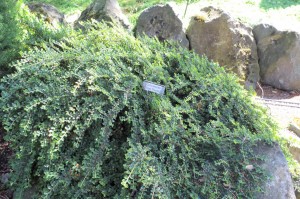Hypertufa is a method of using cement to create light yet strong rock-like castings or scenery. I plan on using a lot of artificial rock scenery in my railroad instead of moving literally tons of rock and earth. The mixture is simple to make. Here’s my take on a recipe:
Hypertufa: 1 part patching cement, 1.5 parts perlite and 1.5 parts peat moss. It will take 0.5 to 0.75 parts water to make this the right consistency.
Note: The cement dust is very irritating to skin. I learned that gloves are very important. I got a rash where my hand touched the dust on the bag when scooping out the cement.
On the left is hypertufa on hardware cloth. I had the mixture too thin, but it still worked okay. I would probably “paint” another coat over this and do some sculpting. On the right is an aluminum foil casting. Both methods are likely to be used.


























 One thing to remember, since I want to be able to see the rock-work along the railroad, is to not let the ground covers take over. Since this is Oregon, that might be easier said than done!
One thing to remember, since I want to be able to see the rock-work along the railroad, is to not let the ground covers take over. Since this is Oregon, that might be easier said than done!